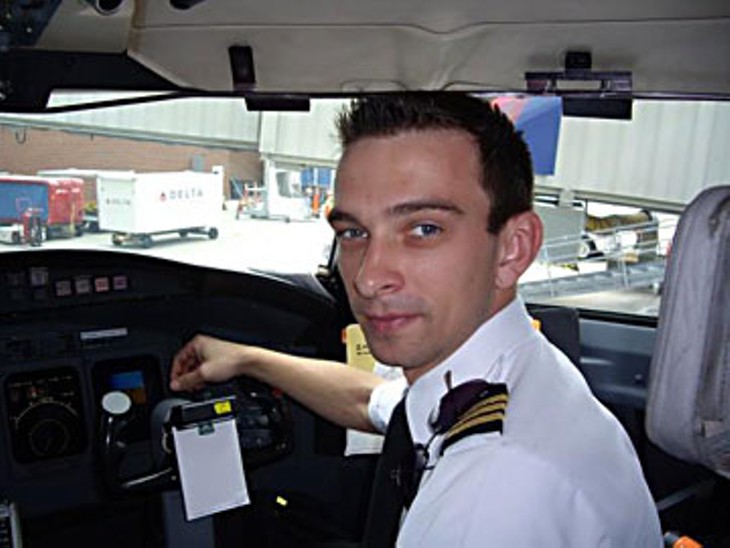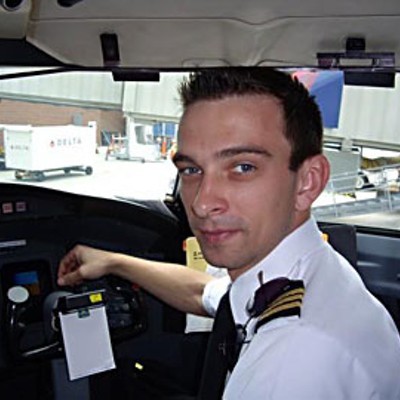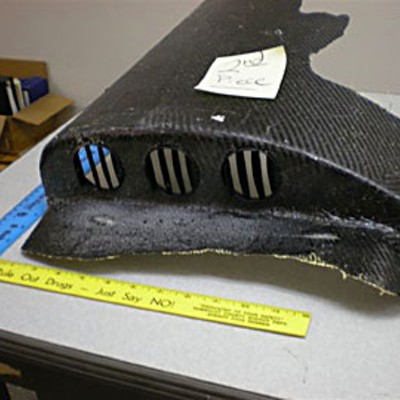[
{
"name": "Top Stories Video Pair",
"insertPoint": "7",
"component": "17087298",
"parentWrapperClass": "fdn-ads-inline-content-block",
"requiredCountToDisplay": "1"
}
]
The disappearance of a small, single-engine aircraft off the coast of Trinidad the stormy night of Sunday, March 1, has prompted many questions. Foremost among those is what became of the plane, passenger Rick Gustafson (not to be confused with the local man of the same name) and 30-year-old pilot Vladislav Milushev, a Florida man who had recently been furloughed from Comair Airlines, a Delta carrier with a hub in Orlando. Photos of debris that washed ashore between Patrick's Point and Agate Beach in the days following the disappearance were sent by the Sheriff's Department to the plane's manufacturer, Diamond Aircraft of Canada. The company said that, in all likelihood, the debris came from the missing DA40. Milushev's family has planned a memorial service for April 5 in Florida.
Yet many questions remain. Per usual procedure, Milushev had been talking with the Federal Aviation Administration's air traffic control center in Seattle, Wash. His last radio contact took place eight-tenths of a mile northwest of Trinidad Head at a perilously low altitude of just 100 feet. (The Eureka-Arcata airport is at 221 feet.) After communications with the plane had been lost, an employee at the Eureka-Arcata airport reportedly told the Seattle dispatcher that the Milushev's plane had actually landed and was on the tarmac. This erroneous report resulted in a 12-hour delay in search and rescue efforts by the U.S. Coast Guard, which wasn't told of the missing plane until the following morning.
Once notified by the Sheriff's Office, Coast Guard personnel immediately began searching up and down the coastline and continued doing so for the next 10 hours, according to Lt. Russel Merrick. But it may have already been too late. "The water temperature up here is about 50 degrees," Merrick said. "Survivability in normal street clothing -- you're looking at two to three hours."
FAA spokesman Ian Gregor said he didn't know who made the apparently false landing report, though he said, "It certainly wouldn't be the first time somebody mistook one airplane for another." He suggested asking local airport personnel. However, numerous attempts to reach Humboldt County Airports Manager Jacqueline Hulsey for comment were unsuccessful. On Tuesday afternoon, she suggested through an airport employee that the Journal call the FAA.
Like more than 300 other airports nationwide, the Eureka-Arcata airport used to include a flight service station where air traffic control specialists monitored landings and updated pilots on weather conditions. But in the 1990s, the FAA closed all flight service stations in the continental United States, replacing them with automated systems. In 1997, then-Congressman Frank Riggs authored a House Bill arguing against the closure of our local station on the grounds that the weather here justified its existence. (The airport, built during World War II, was originally used by the U.S. Navy for the sole purpose of instructing naval pilots on inclement weather operations.)
Arguing before the House subcommittee on aviation, Riggs said a human-monitored service station is critical for a location where the weather can change drastically in minutes. "I personally believe," Riggs said, "that this decision by the FAA is dangerously shortsighted and one which could -- and I think is -- jeopardizing the safety of travelers to the California north coast."
Fieldbrook resident Rick Ohman was an airport service worker at the Eureka-Arcata airport for roughly 30 years. Typically, Ohman said, when the Seattle air traffic control operators called to verify a landing, he would ask for the plane's "N number," or registration number, then run out to make sure it was there. "I can't imagine any more important duty," Ohman said. He called the elimination of the manned flight service station "just stupid," but added that the existing technology should have prevented the false report. Radar located atop Rainbow Ridge near Ferndale gives Seattle operators information so clear, he said, that they used to brag that they could practically see the runway.
Nonetheless, Gregor said the FAA won't be investigating the matter because it's not their jurisdiction. When asked whose it was, he responded, "Nobody's." He again suggested speaking with local airport personnel but implied that, whatever happened that Sunday night, it's a moot point. "You gotta separate that 'it appears somebody gave us inaccurate information' from 'it appears there was a crash,'" Gregor said. If the employee had reported that the plane had not in fact landed, "[It] wouldn't have changed the fact that the plane went down," he said. Perhaps not. But isn't it possible that the men survived the crash? That they could have been rescued had the Coast Guard been notified immediately? "I'm not gonna go there because I don't know what happened," Gregor responded.
"Maybe it's no big deal," Ohman said of the incident. "They were probably killed instantly. But it's horrible to think they might have been floating out there for hours." Either way, he said, "the family deserves answers."
Comments (4)
Showing 1-4 of 4
more from the author
-
Last Days of the Surfing DA
Heading into his final year in office, Paul Gallegos talks politics, family and The Smiths
- Jan 2, 2014
-
Unequal Opportunities
Behind the ACLU's allegations of racial, sexual and disability discrimination in local schools
- Jan 2, 2014
-
Systematically Misled
- Dec 26, 2013
- More »




































